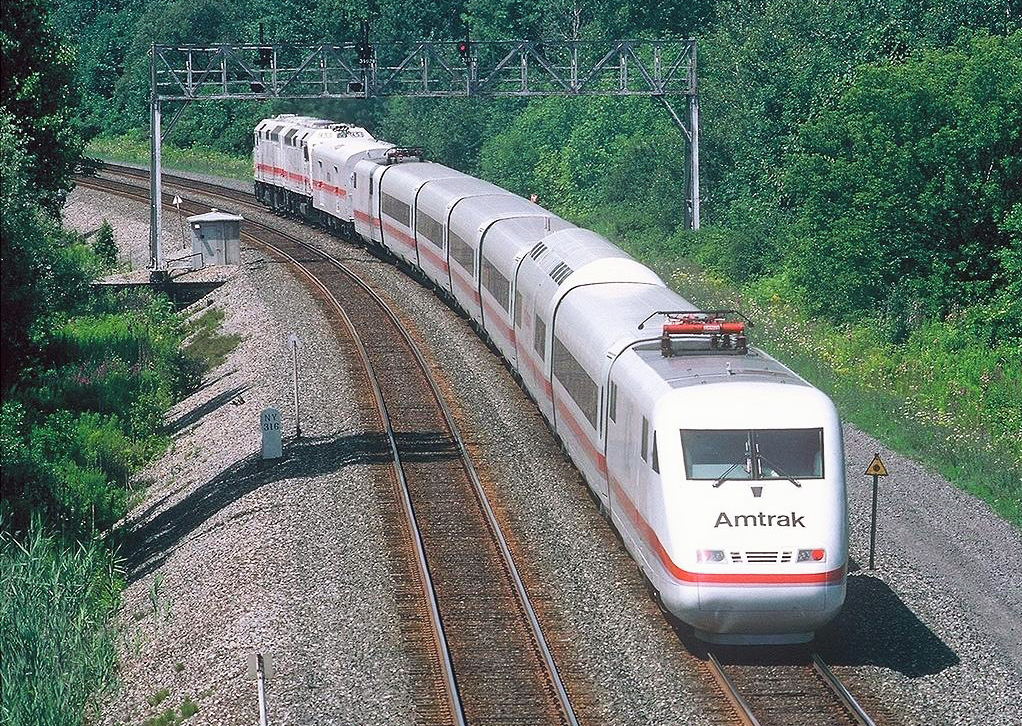Amtrak's "Intercity Express" (Train): Tests, Routes, Photos
Last revised: February 26, 2025
By: Adam Burns
The Intercity Express (ICE) is a hallmark of German engineering, symbolizing efficiency, speed, and innovation in rail travel. Since its inauguration, the ICE has transformed the landscape of high-speed rail in Europe and beyond.
Among its various train models, the ICE 1 holds particular historical significance in the U.S. thanks to its early development and transatlantic testing with Amtrak in 1993.
As the carrier pursued the goal of establishing high-speed service along the Northeast Corridor, it explored two cutting-edge foreign train designs: Sweden's X2000 and Germany's Intercity Express (ICE Train).
The Intercity Express, developed by Siemens, was operational between Washington, D.C., and New Haven, Connecticut, during 1993. According to Amtrak, the ICE Train achieved a top speed of 165 mph and was showcased in various cities nationwide to gauge public interest and demonstrate its capabilities.
Despite its impressive performance, Amtrak ultimately opted against purchasing the German built trainset.
 The ICE 1 trainset tours over Conrail (ex-New York Central) at Port Byron, New York on August 13, 1993. Wade Massie photo.
The ICE 1 trainset tours over Conrail (ex-New York Central) at Port Byron, New York on August 13, 1993. Wade Massie photo.Introduction
The inception of the Intercity Express dates back to the late 20th century, when Deutsche Bahn (DB), the German national railway company, sought to create a high-speed rail network that could efficiently connect major cities across Germany and, eventually, neighboring countries. The result was the ICE, a series of trains engineered to operate at extraordinary speeds while providing unmatched comfort and reliability.
Development of ICE 1
The ICE 1 is the pioneering model in the Intercity Express family. Introduced in 1991, it was the first series of high-speed trains to run on the German rail network. At the core of its design was the ambition to create a state-of-the-art train that could reach speeds of up to 280 km/h (174 mph) while ensuring passenger safety and comfort.
Equipped with advanced technology, streamlined aerodynamics, and high-capacity engines, the ICE 1 consisted of power cars at both ends and a series of intermediate passenger cars, ensuring a balanced and powerful configuration. Each trainset typically included two power cars and up to 12 passenger cars, segmented into different classes to cater to a variety of travelers.
Design and Features
The ICE 1 trainsets were notable for their sleek design, which minimized drag and maximized speed. The passenger experience was a crucial focus, with interiors designed to offer a premium level of comfort akin to air travel. Features included:
- **Spacious Seating:** Configuration featuring adjustable seats with ample legroom and reclining options.
- **Dining Services:** A dining car offering a range of meal options, enhancing the travel experience.
- **Noise Reduction:** Enhanced insulation and soundproofing to ensure a quiet environment even at high speeds.
- **Climate Control:** Advanced heating and cooling systems to maintain a comfortable atmosphere irrespective of external weather conditions.
- **Modern Amenities:** Information screens, public address systems, and on-board services to keep passengers informed and entertained.
Amtrak's Exploration of High-Speed Rail: The 1993 Tests
In 1993, Amtrak, the United States' national rail operator, undertook a groundbreaking collaboration with Deutsche Bahn to evaluate the viability of high-speed rail travel in the U.S. For this purpose, an ICE 1 trainset was transported to the United States for a series of test runs.
Objectives of the Testing
The primary aim of the testing was to explore the operational potential and passenger reception of high-speed rail in the American context. Several key aspects were scrutinized:
1. **Infrastructure Compatibility:** Assessing the existing rail infrastructure's ability to support high-speed operations.
2. **Technical Performance:** Evaluating the performance of the ICE 1 on American tracks under various conditions.
3. **Market Reception:** Gauging public interest and potential market demand for high-speed rail services.
4. **Operational Feasibility:** Identifying any logistical or operational challenges unique to the U.S. railway system.
The Test Routes
In June 1993, an eight-car trainset was shipped from Bremerhaven, Germany. The trainset comprised two power cars—#401 084-9 and #401 584-8—along with one first class car, two second class cars, a restaurant car, and a service car.
For more reading on the demonstration set please visit this site.
Amtrak Test Set
| Car | Number |
|---|---|
| Power car | 401 084-9 |
| Car 1 | 802 855-7 |
| Car 2 | 802 657-7 |
| Car 5 | 802 438-2 |
| Car 9 | 803 056-1 |
| Car 10 | 804 051-1 |
| Car 14 | 801 856-6 |
| Power car | 401 584-8 |
Prior to its arrival, starting in April 1993, the train had been modified to operate on the Northeast Corridor, adapting to the 11 kV, 25 Hz electrification system and altering wheel profiles for compatibility.
The trainset embarked on presentation runs to 25 cities across the U.S. and Canada. Beginning October 4, it was incorporated into Metroliner service between Washington, D.C., and New York City for a duration of two months. On other routes, the trainset was hauled by diesel locomotives, specifically the experimental F69PHAC - an EMD design.
Siemens and AEG-Westinghouse were vying for a substantial contract with Amtrak to supply 26 trainsets for high-speed service on the Boston–New York–Washington corridor, which would eventually evolve into the Acela Express. Had they secured the bid, production would have taken place at five General Motors Electro-Motive Division plants in the United States.
Performance and Results
The ICE 1 performed impressively during its test runs, achieving speeds significantly higher than conventional American trains. Tests demonstrated that the trainset could operate efficiently on existing tracks, although some upgrades would be necessary to fully realize its speed potential.
Passenger reactions were overwhelmingly positive, with many appreciating the comfort, speed, and overall experience offered by the ICE 1. This reception hinted at a substantial market interest, particularly in regions where air and road travel were becoming increasingly congested.
Challenges Identified
While the tests showcased several advantages, some challenges were also highlighted:
- **Infrastructure Needs:** Significant investments in track improvements, signaling systems, and station modifications would be required to support consistent high-speed service.
- **Regulatory Hurdles:** Compliance with American safety standards and regulations posed additional layers of complexity.
- **Cultural Adaptation:** Adapting the high-speed rail concept to fit the unique travel culture and behavior of American passengers necessitated thoughtful consideration.
Impact of the 1993 Tests
The 1993 testing of the ICE 1 on Amtrak tracks represented a pivotal moment in the conversation about high-speed rail in the United States. It validated the technical feasibility and market potential of high-speed rail, lending impetus to ongoing debates and planning efforts.
Though high-speed rail development in the U.S. has been slow and fraught with challenges, the groundwork laid by these early tests provided invaluable insights that continue to influence policy discussions and infrastructure planning.
Notably, the Acela Express, Amtrak's venture into higher-speed rail service in the Northeast Corridor, was partly inspired by the success of these initial tests.
ICE Evolution: From ICE 1 to Modern High-Speed Trains
Since the introduction of the ICE 1, the Intercity Express series has evolved significantly, with subsequent models boasting improvements in speed, technology, and passenger amenities.
Models such as the ICE 2, ICE 3, and ICE 4 have built on the foundational principles established by the ICE 1, each iteration incorporating advancements to enhance performance and passenger experience.
ICE 1's Continuing Legacy
Despite being surpassed by newer models, the ICE 1 remains a testament to the power of innovative engineering and international collaboration. Many of the original trainsets have been refurbished and continue to serve in the German rail network, showcasing their enduring capability and adaptable design.
ICE 1 Data Sheet
| Specifications | Details |
|---|---|
| Manufacturer | AEG, ABB, Henschel, Krauss-Maffei, Krupp [de], Siemens Mobility |
| Constructed | 1989–1993 |
| Overhauls | 2005–2008 (first time) 2019–present (second time) |
| Number built | 60 |
| Formation | 2 power cars, 12 intermediate cars 2 power cars, 9 intermediate cars (Second Overhaul) |
| Capacity | 743 seats (12 car trainset) |
| Maximum speed | 175 mph |
| Weight | 836 long tons; 936 short tons (12 car trainset) |
| Power output | 12,874 HP (GTO power converters) 10,192 HP (IGBT power converters) |
| Electric system(s) | 15 kV 16.7 Hz AC |
| Current collector(s) | Pantograph |
| Track gauge | 4 feet, 8 1⁄2 inches (standard gauge) |
Conclusion
The ICE 1 is not just a high-speed train; it is a symbol of pioneering spirit and cross-border innovation in rail technology. Its 1993 test runs on Amtrak tracks stand as a significant milestone in the efforts to introduce high-speed rail to the United States.
By pushing the boundaries of what rail travel could achieve, the ICE 1 has left an indelible mark on both European and American railroading history.
As high-speed rail continues to gain traction globally, the lessons and insights gleaned from the ICE 1's transatlantic testing will remain relevant, serving as a catalyst for future advancements in this dynamic field.
Whether for its technological prowess, the comfort it offers, or its role in fostering international collaboration, the ICE 1 will always be a celebrated chapter in the story of high-speed rail innovation.
Recent Articles
-
Virginia Wine Tasting Train Rides
Jul 07, 25 10:45 PM
Wine tasting trains in Virginia provide just that—a unique experience that marries the romance of rail travel with the sensory delights of wine exploration. -
Vermont Wine Tasting Train Rides
Jul 07, 25 10:39 PM
Known for its stunning green mountains, charming small towns, and burgeoning wine industry, Vermont offers a unique experience that seamlessly blends all these elements: wine tasting train rides. -
Indiana's Whiskey Train Rides
Jul 07, 25 10:31 PM
Whether you're a local resident or a traveler looking to explore Indiana from a unique perspective, hopping on a whiskey train ride is a journey worth considering.


